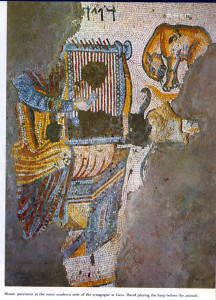Sadly enough, the city of Gaza is nowadays mostly associated with the eruption of fierce violence, even with outright war, and reminds us that a convoluted relationship between ethnic, religious and political groups can easily set a whole region on fire. What a world of difference seems to lie between contemporary Gaza and the very same city in late antiquity: recent scholarship in Classics, History and Patristic Studies has made the case for a peaceful and beneficial symbiosis in the Palestinian polis of Gaza. There, in a Hellenised civic community of the sixth century, trade routes met and different ethnic and religious communities lived together, as it seems without any rifts or violent clashes.
In addition, the multi-ethnic, multi-religious trade hub appears to have been a fertile ground for the cultural sector: sophists delivered speeches in public, the bishop restored beautifully church buildings, poets celebrated spring and love, and sumptuous artworks adorned public and private buildings. Steve Werlin, whose monograph on synagogues in southern Palestine has just come out (Brill, 2015), has taken a fresh look at the remains of the sixth-century synagogue at Gaza-Maiumas. His observations on inscriptions and the mosaic of King David seem to corroborate this image of the late antique city. That David is depicted in the manner of the mythical bard Orpheus (see image) suggests that the Jews of Gaza were well-integrated in their Greek and Christian surroundings and made use of the same iconography as any resident of Gaza, whatever their religious allegiance.
 (source: http://academic.brooklyn.cuny.edu/classic/wilson/classics%2037/sources5/32gaza.htm)
(source: http://academic.brooklyn.cuny.edu/classic/wilson/classics%2037/sources5/32gaza.htm)
Could late antique Gaza serve as a template for the ailing city in the 21st century? Jan Stenger, MacDowell Professor of Greek at the University of Glasgow, studies how education in sixth-century Gaza shaped the cultural identity of the polis. The premise is that learning is a vital mechanism for establishing and negotiating ethical and religious value systems, and so the project aims by a reassessment of sources on education to establish an accurate picture of the cultural climate of Gaza. Luckily, there is rich evidence on teaching and learning from this period: from the letters of the teachers Aeneas and Procopius, to the epideictic speeches of Choricius, to religious instructions of Dorotheus of Gaza. The close analysis of these and further documents will enable us to gain a better understanding of how intellectual leaders tried to come to terms with the relationship between religion and secular culture, and to what extent their ideas contributed to a harmonious community. Research into ancient approaches to cultural and religious identities may also make us reflect on our modern views on the place of religion in politics and identity construction.

